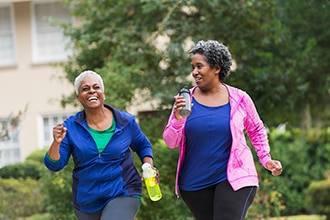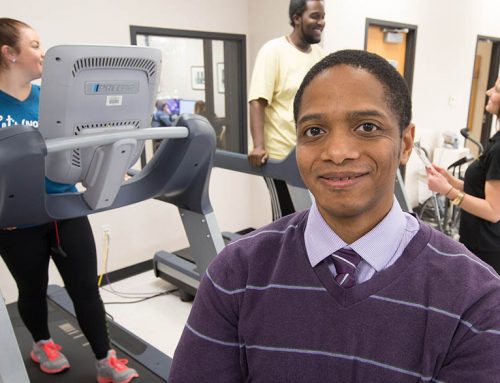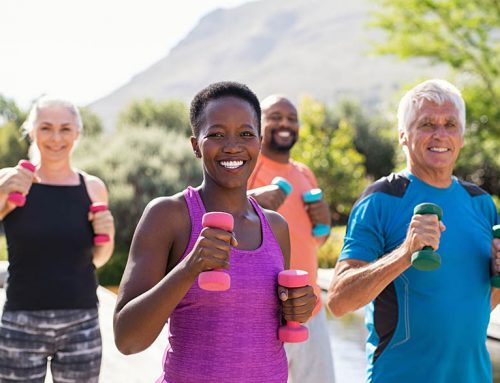Get Active for Your Health
It’s easy to sit more than you should. Many people sit at desks during the day, where we’re inactive for long periods of time. Moving more and sitting less can have major health benefits. Getting regular physical activity is one of best things you can do for your health.
Experts recommend adults get at least 150 minutes (two and a half hours) of moderate physical activity a week. That means doing activities that get your heart beating faster.
If you do more intense exercise like running, aim for at least 75 minutes a week. Adults should also do activities that strengthen their muscles twice a week.
But only about 20% of Americans meet these physical activity goals. The good news is that any physical activity is better than none. And getting active has both immediate and long-term benefits.
Benefits for Everyone
Physical activity has powerful benefits for almost everyone.
“If we could bottle up what physical activity does for us, we would probably have the most powerful pill ever developed,” says Dr. John Jakicic of the University of Pittsburgh. Jakicic is an expert on physical activity and weight control.
Physical activity can help you feel and function better. It can improve your sleep, energy level, and focus. It can help you stay at a healthy weight.
It also helps prevent many diseases, including heart and blood vessel disease, cancer, type 2 diabetes, and depression. Regular physical activity also helps those already diagnosed with these conditions. It can work immediately to reduce anxiety and lower blood pressure.
“It’s been shown over many decades that physical activity is one of the most important actions that people of all ages can take to improve their health,” explains Dr. Kong Chen, an NIH expert who studies how the body uses energy.
For older adults, physical activity can lower the risk of falls. It also helps reduce injuries if you do fall. It reduces the risk of dementia and improves cognition, or your ability to learn, remember, and think. And staying fit enough to perform everyday tasks can help you live independently for longer.
Children benefit, too. Physical activity helps the body to grow and develop. Studies show that being active improves bone health for young children. It also improves brain function for older children. Experts recommend that kids ages six to 17 do one hour or more of physical activity daily.
Research shows that even pregnant women should be active. It lowers your risk of gaining too much weight during pregnancy. That can reduce your chances of developing diabetes from pregnancy. It also helps lessen symptoms of depression after giving birth.
In short, being physically active is recommended for nearly everyone.
How to Move More
Physical activity doesn’t mean you have to go to the gym. Getting more active can include simple things like carrying your groceries or taking the stairs instead of the elevator.
“People mistakenly think that you have to do it a certain way,” says Jakicic. “That you have to get your heart rate into a certain zone, you have to work really, really hard, and you have to go to a special facility and wear special clothes.” But little choices to be more active can still have big effects.
Meeting the 150-minute goal may seem overwhelming. But you can start with a few minutes at a time.
“If time is a barrier, you can still gain benefits by breaking your exercise sessions into smaller periods of time,” says Jakicic.
For example, you could take three 10-minute walks throughout the day to meet a 30-minute goal.
Recent research suggests you can benefit from even a couple of minutes of activity. Every minute counts when it comes to movement.
A Step in the Right Direction
Walking is an easy way to get moving. But some places make that easier than others. Studies have found that your neighborhood can affect how active you are. Scientists have asked what makes a neighborhood “walkable.”
“We found that things like having destinations close by to where you live certainly encourages more walking,” says Dr. Brian Saelens of the University of Washington and Seattle Children’s Research Institute. People are more likely to walk to a nearby store, for example.
Saelens’ team studies how environment influences physical activity and eating.
“Walkable neighborhoods also have more connected street networks,” he says, “so it’s easy to get from point A to point B without taking a long route around.”
His research also suggests that children are more physically active when they live near parks and playgrounds. Learn how to make your neighborhood healthier and safer.
Strategies to Get Moving
Knowing you should be more active and doing it are two different things. Studies have found that the approaches that work vary from person to person.
“One solution that may work for one person may not work for others,” notes Chen.
Some find that using wearable devices or phone apps to track progress can be motivating. Other people may benefit from joining a group that does physical activity together.
Making physical activity social can make it more fun and feel less like a chore. Try to find someone you enjoy being active with. That can be particularly important for kids, who are more likely to be active with others.
Parents also play a key role in keeping their kids active. “Parents need to model being active and provide opportunities for activity,” Saelens says. Ask your child to take a walk with you. Even if they don’t come, you’re modeling the behavior.
If low energy is keeping you from being active, schedule exercise for a time of day when you have the most energy. Tell yourself that physical activity will increase your energy level. It usually does.
So, find what works for you. It could be riding bikes with a friend, going out dancing, or taking a mid-day stroll.
“Any activity is better than no activity,” says Jakicic. “Don’t look for the magic bullet. Look for what works in your lifestyle, look for what works for you, and then try to build on that every day.”
For more tips on getting physical activity, see the Wise Choices box.





Leave a Reply